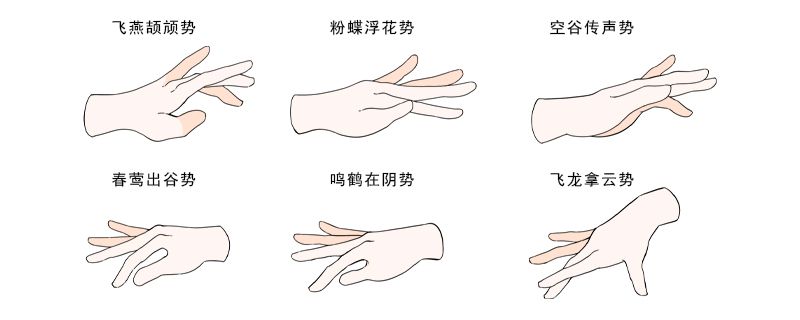Daily practice of Guzheng
The fingerings that Guzheng must practice every day include hook, hold, split, pick, wipe, tick, hit and so on. These fingerings are all basic single fingerings, and different fingerings can be combined with each other to form more complex compound fingerings. These fingerings are the basic fingerings of guzheng playing, and it takes a lot of practice to use them proficiently.

1. Support
When playing, pluck the strings outward with the major finger, that is, pluck the strings in the direction of the bass. The plucking angle is appropriate to apply force diagonally downward. And avoid the first and second joints of the big finger to bend the string diagonally upwards. The movement of the support is a natural, ingenious and coordinated movement through the shoulders, arms, hands and false nails. The small joints of the fingers are not bent, and the base of the big finger is used as the base, and the force is naturally exerted. Pluck the strings diagonally downward. Continuous care is referred to as "lian care". You can use the method of continuously supporting your fingers without leaving the strings, or you can use the method of ricochet (the fingers rise and play again after each note is played).
2. hack
When playing, plucking the strings in the big finger means plucking the strings in the direction of the higher notes. The action of the split is still based on the joint where the big finger connects to the base of the palm, and the string is slightly inclined to the upper angle.
3. Wipe
When playing, pluck the strings with the index finger inwards. Wipe is often used to play with the big or middle finger, and is also used for single-tone or ascending scale plucks. "Forefinger Shake" and "Three Hook Wheel Wipe" fingerings both contain wipe fingerings.
4. Pick
When playing, pluck the strings with the index finger outwards. There are two ways to pluck the strings outward with the index finger: one is that the big finger is attached to the first joint of the index finger, and the wristband finger is used to pluck the strings with the help of the big finger; Fingers pluck the strings; the other is that the index finger relies on the plucking of its own first and second joints to pluck the strings with the armband fingers. Both methods require the middle, name and little fingers to be naturally relaxed and slightly contracted.
5. Tick
Play with the middle finger inwards. The action of picking the strings inward with the middle finger takes the third joint of the base of the middle finger as the moving point, and drives the movement of the omnidirectional fingers slightly downward. It should be noted that the first and second joints are not bent, and are in a natural relaxed state, and at the same time, there is a certain amount of power in the relaxation. It is based on relaxation and maintaining a certain force to play. The hook's angle of contact should always be based on the strumming of the string, rather than hooking the string like a hook. A good tone and sound quality can only be achieved by playing the strings diagonally below.
6. Tick
Pluck the strings with the middle finger outwards when playing. Tick is not used alone. Tick is often used in comprehensive fingerings such as "anti-pick", "tick-pick" and "anti-heavy pinch" in conjunction with the big finger. .
7. Hit
When playing, the ring finger is plucked inward. Play performances that are often used for arpeggios or broken chords. Since the ring finger generally does not wear false nails, the individual sounds are plucked with the ring finger to obtain soft color contrast and soft sound effect. In addition, in the performance of some chords, there is also the "hit" fingering of the ring finger.
The fingering of Tuo is to pluck the string with the thumb to the outside, and the fingering of the split is to pluck the string with the thumb to the inside. Among them, the fingering of Tuo is the most basic fingering when playing the guzheng. This basic fingering is often used in some monophonic performances. . The direction of the split fingering is the direction of the treble, and the direction of the support fingering is the direction of the bass.
The split fingering is not played straight up, but at a slightly sloping angle. The directions of the split and tow fingerings are completely opposite, but the technique of playing is exactly the same. The two fingerings are often used together, but not simultaneously, but alternately.
When the two fingerings are used together, most of the fingerings are used first, followed by the fingering of split, so that the melody played is more harmonious and beautiful. In addition, the fingering of the hook is also relatively common, and it will be used in conjunction with the fingering of the support.
The above are the fingerings that must be practiced every day for learning the guzheng. Have you practiced them? It has beautiful timbre and charm and is known as the "Oriental Piano". It is not only pleasing to the ear, tastes both elegant and popular, but also easy to learn to play and has obvious results; it is an excellent national musical instrument that is very easy to be accepted by people. But learning musical instruments is only a small part, and insisting on hard practice is the shortcut to success.
 渝公网安备 50010702504639号
渝公网安备 50010702504639号